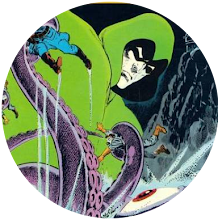Sometimes you can't help feeling a super-villain wouldn't half benefit from getting out a bit more. Ronan the Accuser's the latest of those as, having decided that turning the human race into cavemen isn't enough, a few pages into this issue he decides he'd rather turn us into amoebae. At this point maybe someone should tell him he's devoting far too much time to all this. Ronan, get out of the house. Go to a movie. Go on a date. Try your hand at Laser Quest. Write a blog. There's so much more to life than planning ever more extreme ways of de-evolving people.
Then again, maybe the problem is he gets out too much. Like Thunderbirds' The Hood, for a man in charge of a vast organisation, he seems remarkably hands-on. Why does a being who now rules an inter-stellar empire have to travel all the way to Earth just to press some buttons? Couldn't he have stayed back home and got someone else to do all this?
Meanwhile the Avengers are still making a Horlicks of dealing with his Sentry, finally succumbing to it, with only Rick Jones and Quicksilver escaping. Fortunately the day's saved when Rick liberates Captain Marvel's uni-beam wrist blaster and uses it to destroy Ronan's control panel, dooming the whole exercise. To make matters worse for our giant-sized judge, news comes in that the Kree galaxy's now at war with the Skrull galaxy, so he has to go back home, leaving the human race as multi-celled as always.
To a large degree, the vast majority of this issue really doesn't advance the plot by one inch. Hank Pym's still a caveman for most of it, Goliath's still helping the Sentry fight the Avengers, and Ronan's still out to de-evolve everyone, spending virtually the whole story boasting about his plans rather than actually instigating them. Captain Marvel meanwhile hangs around in shackles doing nothing. It's only at the climax that things suddenly change, with the foiling of Ronan's scheme, everything on Earth returned to normal and an outbreak of war that at the time seems of no great significance, just an overly-convenient plot device to get rid of the villain. As such, you could argue that, competent as they are, seventeen of its twenty pages don't really serve any great purpose in existing.
There is however one significant development during all this, and that's that, captured by Ronan, the Vision and Scarlet Witch finally get their romance going as they almost get to kiss, before the Vision's angst prevents it. Up until this point, there've been hints of it but at last we're being hit over the head with the frying pan of love. I'm sure most will view this as a good thing. In its early days, the Vision and Scarlet Witch's love story was arguably the most compelling romance yet seen in comics - even if Quicksilver might not agree.
That aside, the most appealing bit of characterisation comes from an unlikely source. The Sentry. Abandoned by Ronan, lacking any orders, the Sentry sacrifices itself trying to save the now collapsing base, even though it knows the task is hopeless. It might be a conscienceless machine but it does have a certain nobility about it.
The other moment of significance is that it's Rick Jones who ultimately foils Ronan's plan. Coincidence? Or signs of Roy Thomas already having a master plan for the whole thing in place?
Subscribe to:
Post Comments (Atom)







































































2 comments:
"In its early days, the Vision and Scarlet Witch's love story was arguably the most compelling romance yet seen in comics" -- I can't be objective here, but I sure remember how sophisticated and mature it seemed when I was eight years old! And the slow buildup over many preceding months gave the reveal a big emotional charge, which is something no comic could have pulled off before Marvel made multi-issue subplots one of its distinctive ingredients.
I do feel it was Quicksilver's opposition that really made it work. Take that away and it's just a love story. With Quicksilver added, it's suddenly a battle against bigotry and an impassioned plea for open-mindedness.
Post a Comment